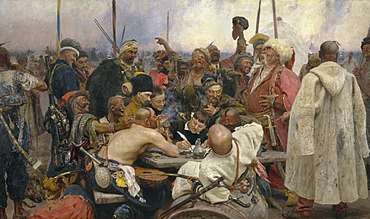Koliyivshchyna
Koliyivshchyna (Ukrainian: Коліївщина, Polish: koliszczyzna) was a major haidamaka rebellion that broke out in Right-bank Ukraine in June 1768,[1] caused by the dissatisfaction of the peasants with serfdom,[2] the anti-nobility and anti-Polish moods among the Cossacks and peasants.[3][4] The uprising was accompanied by violence against Poles, Jews and Roman Catholic and Uniate clergy, culminating in the massacre of Uman.[5] The number of victims is estimated from 100,000[6] to 200,000[5][7][8]
| Koliyivshchyna rebellion | |||||||
|---|---|---|---|---|---|---|---|
| Part of Bar Confederation and Haidamaky | |||||||
Camp of Haidamakas by Juliusz Kossak | |||||||
| |||||||
| Belligerents | |||||||
|
|
Haidamaky (Cossacks) | ||||||
| Commanders and leaders | |||||||
|
Jan Klemens Branicki Mikhail Krechetnikov |
Melkhisedek Znachko-Yavorsky Maksym Zalizniak Ivan Gonta | ||||||
| Part of a series on |
| Cossacks |
|---|
 |
| Cossack hosts |
| Other groups |
| History |
| Cossacks |
| Cossack terms |
Etymology
The origin of the word is not certain. It could be an adaptation of the Polish words "kolej", "kolejno", "po kolei", which implies "służba kolejna" (patrolling service), designating Cossack militia in the service of aristocrats. That etymology is suggested by historians such as Władysław Andrzej Serczyk and Volodymyr Shcherbyna.[9]
Outlook
It was simultaneous to the Confederation of Bar which originated out of the adjacent region in the city of Bar (historical Podolia) and was a de facto civil war in Poland.
The rebellion was fueled by the circulation of a fictitious proclamation of support and call to arms by Russia's Empress Catherine II, the so called "Golden Charter".[10] Mostly based on rumors, the charter however had a real foundation and was connected with the Catherinian rescript that in 1765 she issued it to Archimandrite Melkhisedek and obligated the Russian ambassador in Warsaw to facilitate assertion of rights and privileges of the Right-bank Ukraine Orthodox confession.[11] In 1764, on territory of the Zaporizhian Host of Right-bank Ukraine and along the southern borders of the Polish-Lithuanian Commonwealth, the Russian Empire created New Russia Governorate in place of previously existing New Serbia province and was intensively militarised.[12]
Preparation to uprising and the initial raid of the Cossack detachment of Maksym Zalizniak started at the Motrynine Saint Trinity Monastery (today a covenant in Chyhyryn Raion), a hegumen of which was Archimandrite Melkhisedek (Znachko-Yavorsky) who also served as the director of all Orthodox monasteries and churches in Right-bank Ukraine (in 1761-1768).[1]
The peasant rebellion quickly gained momentum and spread over the territory from the right bank of the Dnieper River to the river Syan. At Uman it led to a big massacre. Poles, Jews and Uniates were herded into their churches and synagogues and killed in cold blood.[13]
Crowds of insurgents broke into the city [...] Most of the nobles and Jews gathered in the churches, synagogue and town hall. Catholic priests communicated and gave absolution [...] the slaughter initiated, most likely by vengeful peasants, began. According to modern testimonies, about three thousand Jews died in the synagogue alone. Killed and tormented. Jews were cut off their hands and ears. They were pulled out of cellars, houses and even ditches, where they sought shelter in vain. Catholic and Uniate priests became the next victims of the hatred of the insurgent crowd.
In three weeks of unbridled violence the rebels slaughtered 20,000 people, according to numerous Polish sources. The leaders of the uprising were Cossacks Maksym Zalizniak and Ivan Gonta. While being the commander of the Potocki's private Uman city Cossack militia garrison, the latter joined Zalizniak at Uman after being despatched by Polish Count Franciszek Salezy Potocki to protect it.
Eventually the uprising was crushed by Russian troops, aided by Polish army. Both its leaders were arrested by the Russian troops on 7 July 1768.[1] Ivan Gonta was handed over to Polish authorities who tortured him to death, while Maksym Zalizniak was exiled to Siberia.[14] The rebellion was suppressed by the joint forces of Polish and Russian armies, with numerous hangings, decapitations, quarterings and impalings.[7]
Koliyivshchyna in popular culture
Taras Shevchenko's epic poem Haidamaky (The Haidamakas) chronicles the events of the Koliyivshchnyna. The event also inspired recent artwork during the latest Ukrainian unrest.[15]
References
- Koliyivshchyna at Encyclopedia of History of Ukraine
- P.R. Magocsi. A History of Ukraine. pp. 294, 296.
- Franciszek Rawita-Gawroński (1914). Sprawy i rzeczy ukraińskie: materyały do dziejów kozaczyzny i hajdamaczyzny. Lviv. pp. 146, 147.
- Korzon, Tadeusz (1897). Wewnętrzne dzieje Polski za Stanisława Augusta (1764–1794). Cracow-Warsaw. p. 200.
- Kazimierz Karolczak, Franciszek Leśniak (1998). Wielka Historia Polski. Cracow. p. 111.
- Konopczyński, Władysław (1999). Dzieje Polski nowożytnej. Instytut Wydawniczy Pax. p. 619.
- Norman Davis (1982). God's playground. A history of Poland, vol 1. Columbia University Press. ISBN 0-231-05350-9.
- Stanisław Bogusław Lenard, Ireneusz Wywiał (2000). Historia Polski w datach. Warsaw: Wydawnictwo Naukowe PWN. pp. 274–275.
- Chukhlib, T. Judge or understand haidamakas? Taras Chukhlib about Koliivshchyna (Судити чи розуміти гайдамаків? Тарас Чухліб про Коліївщину). Ukrayinska Pravda. 16 December 2015
- Golden Charter at Encyclopedia of Ukraine
- Catherinian Golden Edict at Encyclopedia of History of Ukraine
- First New Russia Governorate at Encyclopedia of History of Ukraine
- Serczyk, Władysław (1972). Hajdamacy. Cracow. pp. 325–326.
- "Koliivshchyna rebellion". Internet Encyclopedia of Ukraine. Canadian Institute of Ukrainian Studies.
- "ICONS ON THE BARRICADES: INCREDIBLE UKRAINIAN PROTEST ART" ArtNews. Retrieved 2015-08-23.
Further reading
- Magocsi, Paul Robert (1996). A History of Ukraine. Toronto: University of Toronto Press. ISBN 0-8020-0830-5.
- Henryk Mościcki, "Z dziejów hajdamacczyzny", Warszawa 1905
- Władysław Andrzej Serczyk, "Koliszczyzna", Kraków 1968
- Władysław Andrzej Serczyk, "Hajdamacy", Wydawnictwo Literackie, Kraków 1972
- Karol Grunberg, Bolesław Sprengel, Trudne sąsiedztwo, Warszawa 2005
- Władysław Wielhorski, Ziemie ukrainne Rzeczypospolitej: Zarys dziejów, Londyn 1959
- Kazimierz Karolczak, Franciszek Leśniak, "Wielka Historia Polski", Kraków 1998
- "Dzieje Polski. Kalendarium", pod red. Andrzeja Chwalby, Kraków 1999
- "Kronika Polski", praca zbiorowa, Warszawa 200
- Stanisław Bogusław Lenard, Ireneusz Wywiał, Historia Polski w datach, wyd. PWN, Warszawa 2000